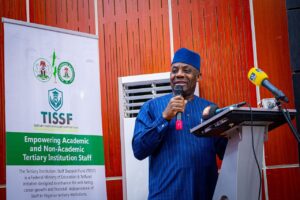
FG Launches New Curriculum for Basic, Secondary, and Technical Schools
- Nigeria News
- 02.09.2025
- 1 Comment
- 99
FG Launches New Curriculum for Basic, Secondary, and Technical Schools

This reform is aimed at reducing subject overload, improving quality learning, and aligning Nigeria’s education system with global best practices.According to the announcement made by Prof. Suwaiba Sai’d Ahmad, the Minister of State for Education, on behalf of the Minister of Education,
Dr. Maruf Tunji Alausa, the new curriculum marks one of the most comprehensive education reforms in recent years.
- Nigerian Educational Research and Development Council (NERDC)
- Universal Basic Education Commission (UBEC)
- National Senior Secondary Education Commission (NSSEC)
- National Board for Technical Education (NBTE)
- Other relevant education stakeholders nationwide
This multi-agency collaboration ensured that the new curriculum is both comprehensive and practical,
addressing the diverse educational needs of Nigerian students across all levels of learning.
This approach aims to prepare students with the right skills to thrive in an increasingly competitive global environment.
Primary School Curriculum
At the primary education level, a tiered subject structure has been introduced:
- Primary 1–3: 9–10 subjects
- Primary 4–6: 10–12 subjects
Junior Secondary School Curriculum
Junior Secondary School (JSS) students will now take between 12–14 subjects.
These subjects combine core areas like English, Mathematics, and Basic Science with vocational and life skills courses that promote holistic learning.
Senior Secondary School Curriculum
Senior Secondary School (SSS) students will focus on 8–9 subjects,
allowing for deeper specialization in science, arts, or commercial tracks, while still retaining a solid general knowledge base.

Technical schools will adopt a structure of 9–11 subjects,
integrating core academics with practical technical and vocational training.
This approach is tailored to equip students with employable skills directly applicable in industries.
Many schools focused on quantity over quality, leading to shallow understanding of subjects and weak problem-solving skills.The new curriculum seeks to address these problems by:
- Reducing subject overload and content repetition
- Providing more classroom time for in-depth learning
- Aligning Nigeria’s education with 21st-century global standards
- Introducing practical and vocational training early in the learning process
- Preparing students for higher education, entrepreneurship, and job markets
This system will track how well schools are adapting to the new curriculum and provide support where needed.According to Prof. Ahmad, implementation will begin immediately, with all schools expected to transition smoothly within a defined timeline.
Teachers will also undergo capacity-building training to familiarize themselves with the new structure.
Many believe it will help Nigerian students become more globally competitive and foster a better learning environment.
“This reform is long overdue. Our children need more practical knowledge and less memorization.
By reducing the number of subjects and increasing depth, the government has taken a step in the right direction,”
said an education analyst
By reducing content overload, pupils and students will have more time to focus on understanding core concepts rather than rushing through multiple subjects.For technical school students, the curriculum ensures early exposure to practical skills in areas such as engineering, ICT, and vocational trades.
This move supports the Federal Government’s agenda to reduce unemployment by empowering youths with job-ready skills.
in Nigeria’s education reform journey. By striking a balance between academic knowledge and practical skills,
the government aims to nurture a new generation of well-rounded, employable, and globally competitive graduates.As the implementation phase begins, all eyes will be on schools, teachers, and policymakers to ensure that
this ambitious reform translates into tangible learning improvements for Nigerian children and youth.

Where official curriculum PDFs live (start here)
Look first at these official homes for curriculum documents:
- NERDC (Nigerian Educational Research & Development Council) primary, junior secondary, senior secondary syllabi and subject standards.
- NSSEC (National Senior Secondary Education Commission) policy notes and senior secondary framework guidance.
- UBEC (Universal Basic Education Commission) basic education implementation resources and teacher guides.
- NBTE (National Board for Technical Education) technical and vocational curricula, competency frameworks.
- Federal Ministry of Education press releases, consolidated frameworks and national rollout announcements.
How to find and download a Senior Secondary curriculum PDF (quick steps)
- Go to the agency site (NERDC or NSSEC) and open the Curriculum / Syllabus section.
- Choose the level: Senior Secondary (SS1–SS3).
- Select the subject you need (e.g., English Language, Mathematics, Physics).
- Look for links or buttons labeled Download, PDF, or Syllabus. Open and confirm the publication/revision date.
- Save the file locally and name it clearly (e.g.,
SSEC_Physics_NERDC_2024.pdf).
If a page shows an overview but no download button, the PDF may be embedded scroll the page or use the browser’s print-to-PDF to save a local copy after confirming the source is official.
Primary & Junior Secondary PDFs what to expect
Primary level
Primary curriculum PDFs usually include subject-by-subject syllabi, learning outcomes, recommended contact hours and pedagogy notes. Use NERDC’s primary curriculum pages or UBEC teacher-support pages.
Junior Secondary
JSS documents align with the 9-year basic scheme. Expect topics sequenced across JSS1–JSS3 with practical activities, assessment guidance and progression maps.

Technical & Vocational curriculum PDFs (NBTE)
For technical schools, NBTE publishes competency-based curricula, National Occupational Standards (NOS) and course specifications. These PDFs are essential if you’re preparing lesson plans or accreditation documentation for technical colleges.
How to verify a curriculum PDF is official and up-to-date
- Check the host domain: prefer
.gov.ngagency pages (NERDC, UBEC, NSSEC, NBTE, Federal Ministry). - Open the PDF front matter: confirm the title, revision/publication date and approving authority.
- Cross-check announcements: match the PDF date with ministry press releases or circulars about curriculum rollouts.
- Avoid textbook mirrors: textbooks = teaching materials; curriculum = standards/syllabi. Don’t confuse them.
- Federal government new curriculum PDF? Watch the Federal Ministry of Education and NERDC pages; official consolidated frameworks are posted there when released.
- NERDC curriculum download PDF? Yes. NERDC provides subject syllabi and supporting documents by level; locate via its Curriculum/Syllabus area.
- New Senior Secondary curriculum PDF free? Senior Secondary curricula are usually free on NERDC/NSSEC sites; avoid unofficial file-hosts.
- Nigeria Education Curriculum PDF? For a complete set, combine NERDC (primary/JSS/SSS), UBEC (basic support) and NBTE (technical). if you can’t find the PDF
- Use the website’s internal search box with exact phrases like “Senior Secondary Syllabus Mathematics PDF”.
- Check PDF “recent updates” or “resources” sections some agencies place downloads under subject headings.
- Contact the agency’s press or publications office (contact details are usually on their site) to request the official file or link.








1 Comments
[…] Dies in Car Accident Nigerian U.S. Visa Holders Quietly Blocked from Entry as Investigations FG Launches New Curriculum for Basic, Secondary, and Technical Schools 2027: Jonathan 100% Qualified, Ex-President’s Cousin Tells Keyamo, […]